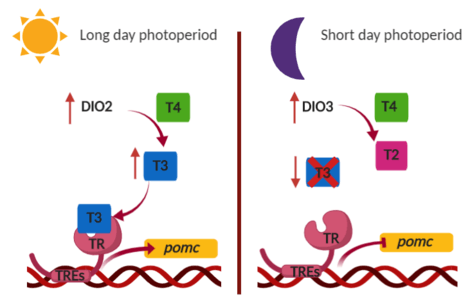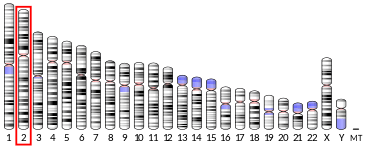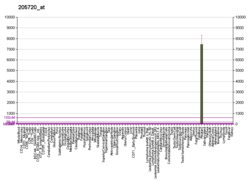Proopiomelanocortin
Pro-opiomelanocortin (POMC) is a precursor polypeptide with 241 amino acid residues. POMC is synthesized in corticotrophs of the anterior pituitary from the 285-amino-acid-long polypeptide precursor pre-pro-opiomelanocortin (pre-POMC), by the removal of a 44-amino-acid-long signal peptide sequence during translation. POMC is part of the central melanocortin system.
| Opioids neuropeptide | |||||||||
|---|---|---|---|---|---|---|---|---|---|
| Identifiers | |||||||||
| Symbol | Op_neuropeptide | ||||||||
| Pfam | PF08035 | ||||||||
| InterPro | IPR013532 | ||||||||
| PROSITE | PDOC00964 | ||||||||
| |||||||||
Function
POMC is cut (cleaved) to give rise to multiple peptide hormones. Each of these peptides is packaged in large dense-core vesicles that are released from the cells by exocytosis in response to appropriate stimulation:
- α-MSH produced by neurons in the ventromedial nucleus has important roles in the regulation of appetite (POMC neuron stimulation results in satiety.[5]) and sexual behavior, while α-MSH secreted from the intermediate lobe of the pituitary regulates the movement of melanin produced from melanocytes in skin.
- ACTH is a peptide hormone that regulates the secretion of glucocorticoids from the adrenal cortex.
- β-Endorphin and [Met]enkephalin are endogenous opioid peptides with widespread actions in the brain.
Synthesis
The POMC gene is located on chromosome 2p23.3. The POMC gene is expressed in both the anterior and intermediate lobes of the pituitary gland. This gene encodes a 285-amino acid polypeptide hormone precursor that undergoes extensive, tissue-specific, post-translational processing via cleavage by subtilisin-like enzymes known as prohormone convertases. The encoded protein is synthesized mainly in corticotroph cells of the anterior pituitary, where four cleavage sites are used; adrenocorticotrophin (ACTH), essential for normal steroidogenesis and the maintenance of normal adrenal weight, and β-lipotropin are the major end-products. However, there are at least eight potential cleavage sites within the polypeptide precursor and, depending on tissue type and the available convertases, processing may yield as many as ten biologically active peptides involved in diverse cellular functions. Cleavage sites consist of the sequences Arg-Lys, Lys-Arg, or Lys-Lys. Enzymes responsible for processing of POMC peptides include prohormone convertase 1 (PC1), prohormone convertase 2 (PC2), carboxypeptidase E (CPE), peptidyl α-amidating monooxygenase (PAM), N-acetyltransferase (N-AT), and prolylcarboxypeptidase (PRCP).
The processing of POMC involves glycosylations, acetylations, and extensive proteolytic cleavage at sites shown to contain regions of basic protein sequences. However, the proteases that recognize these cleavage sites are tissue-specific. In some tissues, including the hypothalamus, placenta, and epithelium, all cleavage sites may be used, giving rise to peptides with roles in pain and energy homeostasis, melanocyte stimulation, and immune modulation. These include several distinct melanotropins, lipotropins, and endorphins that are contained within the adrenocorticotrophin and β-lipotropin peptides.
It is synthesized by:
- Corticotrope cells of the anterior pituitary gland
- Melanotrope cells of the intermediate lobe of the pituitary gland
- Neurons in the arcuate nucleus of the hypothalamus[6]
- Smaller populations of neurons in the dorsomedial hypothalamus and brainstem
- Melanocytes in the skin
Regulation by the photoperiod
The levels of proopiomelanocortin (pomc) are regulated indirectly in some animals by the photoperiod. It is referred to the hours of light during a day and it changes across the seasons. Its regulation depends on the pathway of thyroid hormones that is regulated directly by the photoperiod. An example are the siberian hamsters who experience physiological seasonal changes dependent on the photoperiod. During spring in this species, when there is more of 13 hours of light per day, iodothyronine deiodinase 2 (DIO2) promotes the conversion of the prohormone thyroxine (T4) to the active hormone triiodothyronine (T3) through the removal of an iodine atom on the outer ring. It allows that T3 bind to the thyroid hormone receptor (TR), which then bind to thyroid hormone response elements (TREs) in the DNA sequence. The pomc proximal promoter sequence contains two thyroid-receptor 1b (Thrb) half-sites: TCC-TGG-TGA and TCA-CCT-GGA indicating that T3 may be capable of directly regulating pomc transcription. For this reason during spring and starting summer, levels of pomc increases due to increase levels of T3.[7]
However, during autumn and winter, when there is less of 13 hours of light per day, iodothyronine desiodinase 3 removes an iodine atom which converts thyroxine to the inactive reverse triiodothyronine (rT3), or which converts the active triiodothyronine to diiodothyronine (T2). Consequently, there is less T3 and it blocks the transcription of pomc, that reduces his levels during these seasons.[8] .

Influences of photoperiods on relevant similar biological endocrine changes that demonstrate modifications of thyroid hormone regulation in humans have yet to be adequately documented.
Derivatives
| proopiomelanocortin derivatives | |||||||||
|---|---|---|---|---|---|---|---|---|---|
| POMC | |||||||||
| γ-MSH | ACTH | β-lipotropin | |||||||
| α-MSH | CLIP | γ-lipotropin | β-endorphin | ||||||
| β-MSH | |||||||||
The large molecule of POMC is the source of several important biologically active substances . POMC can be cleaved enzymatically into the following peptides:
- N-Terminal Peptide of Proopiomelanocortin (NPP, or pro-γ-MSH)
- α-Melanotropin (α-Melanocyte-Stimulating Hormone, or α-MSH)
- β-Melanotropin (β-MSH)
- γ-Melanotropin (γ-MSH)
- 𝛿-Melanocyte-Stimulating Hormone (𝛿-MSH, present in sharks[9])
- ε-Melanocyte-Stimulating Hormone (ε-MSH, present in some teleosts [10])
- Corticotropin (Adrenocorticotropic Hormone, or ACTH)
- Corticotropin-like Intermediate Peptide (CLIP)
- β-Lipotropin (β-LPH)
- Gamma Lipotropin (γ-LPH)
- β-Endorphin
- [Met]Enkephalin
Although the N-terminal 5 amino acids of β-endorphin are identical to the sequence of [Met]enkephalin, it is not generally thought that β-endorphin is converted into [Met]enkephalin. Instead, [Met]enkephalin is produced from its own precursor, proenkephalin A.
The production of β-MSH occurs in humans but not in mice or rats due to the absence of the enzymatic processing site in the rodent POMC.
Clinical significance
Mutations in this gene have been associated with early onset obesity,[11] adrenal insufficiency, and red hair pigmentation.[12]
A study concluded that a polymorphism was associated with higher fasting insulin levels in the obese patients only. These findings support the hypothesis that the melanocortin pathway may modulate glucose metabolism in obese subjects indicating a possible gene-environment interaction. POMC variant may be involved in the natural history of polygenic obesity, contributing to the link between type 2 diabetes and obesity.[13]
Dogs
A deletion mutation common in Labrador Retriever and Flat-Coated Retriever dogs is associated with increased interest in food and subsequent obesity.[14]
Drug target
POMC is used as a target for a medication used to treat obesity in humans. The combination of bupropion and naltrexone acts via hypothalamic POMC neurons to decrease appetite.[15]
Two humans with POMC deficiency have been treated with setmelanotide, a melanocortin-4 receptor agonist.[16]
Interactions
Proopiomelanocortin has been shown to interact with melanocortin 4 receptor.[17][18] The endogenous agonists of melanocortin 4 receptor include α-MSH, β-MSH, γ-MSH, and ACTH. The fact that these are all cleavage products of POMC should suggest likely mechanisms of this interaction.
References
- GRCh38: Ensembl release 89: ENSG00000115138 - Ensembl, May 2017
- GRCm38: Ensembl release 89: ENSMUSG00000020660 - Ensembl, May 2017
- "Human PubMed Reference:". National Center for Biotechnology Information, U.S. National Library of Medicine.
- "Mouse PubMed Reference:". National Center for Biotechnology Information, U.S. National Library of Medicine.
- Varela L, Horvath TL (December 2012). "Leptin and insulin pathways in POMC and AgRP neurons that modulate energy balance and glucose homeostasis". EMBO Reports. 13 (12): 1079–86. doi:10.1038/embor.2012.174. PMC 3512417. PMID 23146889.
- Cowley MA, Smart JL, Rubinstein M, Cerdán MG, Diano S, Horvath TL, Cone RD, Low MJ (May 2001). "Leptin activates anorexigenic POMC neurons through a neural network in the arcuate nucleus" (PDF). Nature. 411 (6836): 480–4. Bibcode:2001Natur.411..480C. doi:10.1038/35078085. hdl:11336/71802. PMID 11373681.
- Barrett P, Ebling FJ, Schuhler S, Wilson D, Ross AW, Warner A, et al. (August 2007). "Hypothalamic thyroid hormone catabolism acts as a gatekeeper for the seasonal control of body weight and reproduction". Endocrinology. 148 (8): 3608–17. doi:10.1210/en.2007-0316. PMID 17478556.
- Bao R, Onishi KG, Tolla E, Ebling FJ, Lewis JE, Anderson RL, et al. (June 2019). "Genome sequencing and transcriptome analyses of the Siberian hamster hypothalamus identify mechanisms for seasonal energy balance". Proceedings of the National Academy of Sciences of the United States of America. 116 (26): 13116–13121. doi:10.1073/pnas.1902896116. PMC 6600942. PMID 31189592.
- Dores RM, Cameron E, Lecaude S, Danielson PB (August 2003). "Presence of the delta-MSH sequence in a proopiomelanocortin cDNA cloned from the pituitary of the galeoid shark, Heterodontus portusjacksoni". General and Comparative Endocrinology. 133 (1): 71–9. doi:10.1016/S0016-6480(03)00151-5. PMID 12899848.
- Harris RM, Dijkstra PD, Hofmann HA (January 2014). "Complex structural and regulatory evolution of the pro-opiomelanocortin gene family". General and Comparative Endocrinology. 195: 107–15. doi:10.1016/j.ygcen.2013.10.007. PMID 24188887.
- Kuehnen P, Mischke M, Wiegand S, Sers C, Horsthemke B, Lau S, Keil T, Lee YA, Grueters A, Krude H (2012). "An Alu element-associated hypermethylation variant of the POMC gene is associated with childhood obesity". PLoS Genetics. 8 (3): e1002543. doi:10.1371/journal.pgen.1002543. PMC 3305357. PMID 22438814.
- "POMC proopiomelanocortin". Entrez Gene.
- Mohamed FE, Hamza RT, Amr NH, Youssef AM, Kamal TM, Mahmoud RA (2017). "Study of obesity associated proopiomelanocortin gene polymorphism: Relation to metabolic profile and eating habits in a sample of obese Egyptian children and adolescents". Egyptian Journal of Medical Human Genetics. 18 (1): 67–73. doi:10.1016/j.ejmhg.2016.02.009.
- Raffan E, Dennis RJ, O'Donovan CJ, Becker JM, Scott RA, Smith SP, Withers DJ, Wood CJ, Conci E, Clements DN, Summers KM, German AJ, Mellersh CS, Arendt ML, Iyemere VP, Withers E, Söder J, Wernersson S, Andersson G, Lindblad-Toh K, Yeo GS, O'Rahilly S (May 2016). "A Deletion in the Canine POMC Gene Is Associated with Weight and Appetite in Obesity-Prone Labrador Retriever Dogs". Cell Metabolism. 23 (5): 893–900. doi:10.1016/j.cmet.2016.04.012. PMC 4873617. PMID 27157046.
- Billes SK, Sinnayah P, Cowley MA (June 2014). "Naltrexone/bupropion for obesity: an investigational combination pharmacotherapy for weight loss". Pharmacological Research. 84: 1–11. doi:10.1016/j.phrs.2014.04.004. PMID 24754973.
- Kühnen P, Clément K, Wiegand S, Blankenstein O, Gottesdiener K, Martini LL, Mai K, Blume-Peytavi U, Grüters A, Krude H (July 2016). "Proopiomelanocortin Deficiency Treated with a Melanocortin-4 Receptor Agonist". The New England Journal of Medicine. 375 (3): 240–6. doi:10.1056/NEJMoa1512693. PMID 27468060.
- Yang YK, Fong TM, Dickinson CJ, Mao C, Li JY, Tota MR, Mosley R, Van Der Ploeg LH, Gantz I (December 2000). "Molecular determinants of ligand binding to the human melanocortin-4 receptor". Biochemistry. 39 (48): 14900–11. doi:10.1021/bi001684q. PMID 11101306.
- Yang YK, Ollmann MM, Wilson BD, Dickinson C, Yamada T, Barsh GS, Gantz I (March 1997). "Effects of recombinant agouti-signaling protein on melanocortin action". Molecular Endocrinology. 11 (3): 274–80. doi:10.1210/me.11.3.274. PMID 9058374.
Further reading
- Millington GW (May 2006). "Proopiomelanocortin (POMC): the cutaneous roles of its melanocortin products and receptors". Clinical and Experimental Dermatology. 31 (3): 407–12. doi:10.1111/j.1365-2230.2006.02128.x. PMID 16681590.
- Millington GW (September 2007). "The role of proopiomelanocortin (POMC) neurones in feeding behaviour". Nutrition & Metabolism. 4: 18. doi:10.1186/1743-7075-4-18. PMC 2018708. PMID 17764572.
- Bhardwaj RS, Luger TA (1994). "Proopiomelanocortin production by epidermal cells: evidence for an immune neuroendocrine network in the epidermis". Archives of Dermatological Research. 287 (1): 85–90. doi:10.1007/BF00370724. PMID 7726641.
- Raffin-Sanson ML, de Keyzer Y, Bertagna X (August 2003). "Proopiomelanocortin, a polypeptide precursor with multiple functions: from physiology to pathological conditions". European Journal of Endocrinology. 149 (2): 79–90. doi:10.1530/eje.0.1490079. PMID 12887283.
- Dores RM, Lecaude S (May 2005). "Trends in the evolution of the proopiomelanocortin gene". General and Comparative Endocrinology. 142 (1–2): 81–93. doi:10.1016/j.ygcen.2005.02.003. PMID 15862552.
- König S, Luger TA, Scholzen TE (October 2006). "Monitoring neuropeptide-specific proteases: processing of the proopiomelanocortin peptides adrenocorticotropin and alpha-melanocyte-stimulating hormone in the skin". Experimental Dermatology. 15 (10): 751–61. doi:10.1111/j.1600-0625.2006.00472.x. PMID 16984256.
- Farooqi S, O'Rahilly S (December 2006). "Genetics of obesity in humans". Endocrine Reviews. 27 (7): 710–18. doi:10.1210/er.2006-0040. PMID 17122358.
External links
- Pro-Opiomelanocortin at the US National Library of Medicine Medical Subject Headings (MeSH)
- Overview of all the structural information available in the PDB for UniProt: P01189 (Pro-opiomelanocortin) at the PDBe-KB.
![]()




